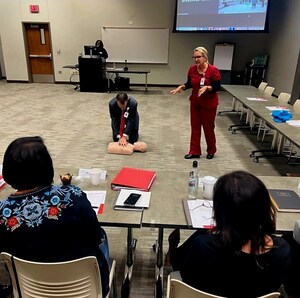Age-Related Gaps Closing, Patient Care and Outcomes Improving at Get With The Guidelines-Stroke Hospitals
American Heart Association rapid access journal report
DALLAS, Feb. 8 /PRNewswire-USNewswire/ -- Age-related gaps in care and outcomes for stroke patients are diminishing as hospitals improve adherence to evidence-based treatments of the American Heart Association/American Stroke Association's Get With The Guidelines–Stroke initiative, according to a new study in Circulation: Journal of the American Heart Association.
"The burden of ischemic stroke is disproportionately borne by older patients, who have a greater incidence and prevalence of this common stroke type than younger individuals," said Gregg C. Fonarow, M.D., lead author of the study and professor of cardiovascular medicine at the University of California-Los Angeles. "Prior studies have suggested lower use of guideline-recommended therapy and worse post-stroke outcomes in older patients. We sought to examine age-related differences among stroke patients cared for in hospitals participating in a national performance improvement program."
Fonarow and colleagues analyzed more than 500,000 ischemic stroke admissions to 1,256 hospitals participating in the Get With The Guidelines–Stroke initiative from 2003 to 2009. They examined age-related differences in patient characteristics, hospital adherence to seven key quality of care performance measures, trends and early clinical outcomes for acute ischemic stroke in patient groups ranging in age from 50 years or younger to 90 years or older.
They found that older patients were more likely than younger stroke patients to have a history of atrial fibrillation or hypertension and less likely to be black, Hispanic or recent smokers.
The researchers looked at hospital adherence to seven pre-defined performance measures, such as use of intravenous recombinant tissue plasminogen activator (IV tPA) in a timely manner. These measures were primary targets for stroke quality improvement efforts in the Get With The Guidelines–Stroke program. Researchers found that performance on all individual process measures was lower in older patients in two groups – those ages 80 to 89 years and those ages 90 years or older – compared to younger patients.
The researchers reported that patients with ischemic stroke were 31 percent less likely to be discharged home and were 27 percent more likely to die in the hospital with each 10-year age increase.
The use of guideline-recommended therapies improved substantially in older patients from 2003 to 2009. Use of IV tPA increased more than three-fold from 20.4 percent in 2003 to 62.4 percent in 2009 in eligible patients age 90 and older. Use of lipid lowering therapy increased dramatically from 15.6 percent in 2003 to 71.7 percent in 2009 in patients age 90 and older. Significant improvements were also noted in the other performance measures.
"While we identified modest age-related differences in individual performance measures, the very good news is that we also noted substantial improvements in performance measures for ischemic stroke from 2003 to 2009 at Get With The Guidelines–Stroke participating hospitals. These include pharmacologic and non-pharmacologic management of stroke in each age group," said Fonarow, immediate past chair of the Get With The Guidelines Steering Committee. "By the end of the study, many of the age-related treatment differences were substantially reduced or eliminated. These findings suggest that Get With The Guidelines–Stroke may have contributed to these very impressive improvements in care."
He said one limitation to the study is the fact that researchers analyzed the care only at Get With The Guidelines–Stroke hospitals, and the findings may not necessarily apply to other U. S. hospitals.
"The Get With The Guidelines–Stroke program is voluntary and the hospitals that participate are more likely to be larger teaching hospitals with a strong interest in stroke care and quality improvement," he said. "But expansion of such national hospital-based quality initiatives for performance improvement in ischemic stroke should be considered to help ensure that eligible patients receive optimal care, regardless of their age."
Co-authors are Mathew J. Reeves, Ph.D.; Xin Zhao, M.S.; DaiWai M. Olson, Ph.D., R.N.; Eric E. Smith, M.D., M.P.H.; Jeffrey L. Saver, M.D.; and Lee H. Schwamm, M.D.
Get With The Guidelines–Stroke is an American Heart Association program supported in part by unrestricted educational grants from Pfizer, Inc. and the Merck-Schering Plough Partnership.
Statements and conclusions of study authors published in American Heart Association scientific journals are solely those of the study authors and do not necessarily reflect the association's policy or position. The association makes no representation or guarantee as to their accuracy or reliability. The association receives funding primarily from individuals; foundations and corporations (including pharmaceutical, device manufacturers and other companies) also make donations and fund specific association programs and events. The association has strict policies to prevent these relationships from influencing the science content. Revenues from pharmaceutical and device corporations are available at www.americanheart.org/corporatefunding.
Editor's note: For more information on stroke, visit the American Stroke Association Web site at strokeassociation.org. More information on Get With The Guidelines–Stroke can be found at www.americanheart.org/getwiththeguidelines.
SOURCE American Heart Association
WANT YOUR COMPANY'S NEWS FEATURED ON PRNEWSWIRE.COM?
Newsrooms &
Influencers
Digital Media
Outlets
Journalists
Opted In






Share this article